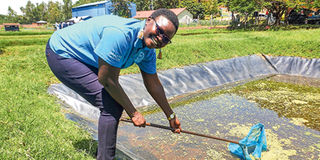Hail weeds, rich feeds for fish, man

Mary Opiyo, a research scientist at KMFRI collects macrophytes from a pond. The aquatic plants that have been found to be rich in omega 3 fats, a vital nutrient especially to the human brain.
What you need to know:
- In 2017, KMFRI, in partnership with Machakos University and Aquaculture Association of Kenya, started research on aquatic plants that would increase omega-3 fatty acids in farmed fish.
- The initiative was funded by Biotechnology and Biological Sciences Research Council (BBSRC), a UK-based organisation.
- The competition for ingredients such as silver cyprinid (omena) comes from human beings and livestock such as poultry and dairy sectors.
- To grow macrophytes, farmers need to drain ponds dry, then disinfect them with lime. The ponds are then refilled and enriched either with fertiliser or organic manure.
A drive on the Kisumu-Homa Bay road leaves one yearning for a piece of fried fish. The aroma leaves you feeling so hungry for a fish bite.
But you would still need to turn left at Nyakwere, then drive for about two kilometres along a murrum road to Kenya Marine and Fisheries Research Institute (KMFRI) Sangora station to reach the fish hub.
Here you find several fish ponds. But you will be struck immediately by how unkempt some of the ponds seem with green weed covering the surface.
But it is these ‘weeds’ that the farmers and fisheries officers have come to learn about; not how to kill them, but how to grow them as a business.
Welcome to the world of macrophytes — aquatic plants that have been found to be rich in omega 3 fats, a vital nutrient especially to the human brain. Omega-3 fats help infants fighting respiratory complications and improve eyesight.
Mary Opiyo, a research scientist at KMFRI, dips what looks like a small fishing net into one of the ponds. Her catch though, is not fish.
She carefully looks at Lemna minor plants, which are a few days old in the pond. In a week’s time, the ponds will be covered with macrophytes as the plants multiply fast.
In 2017, KMFRI, in partnership with Machakos University and Aquaculture Association of Kenya, started research on aquatic plants that would increase omega-3 fatty acids in farmed fish.
The initiative was funded by Biotechnology and Biological Sciences Research Council (BBSRC), a UK-based organisation.
READY FOR FEED FORMULATION
“The research was triggered after discovery that farmed fish had low amounts of the very vital omega0-3 fatty acids, compared to those from natural water sources,” says Dr Patricia Muendo, who leads the Sustainable New Ingredients to Promote Health (SNIPH) project under which the research was carried out.
Farmed fish depend exclusively on commercial feeds, yet they face competition for feed-manufacturing raw materials.
The competition for ingredients such as silver cyprinid (omena) comes from human beings and livestock such as poultry and dairy sectors.
Experts from the three institutions collected various macrophytes from marine and fresh water bodies within the country and analysed the samples for their potential to increase omega-3 fatty acids in farmed fish.
The plants which were found to have great potential include duckweed (lemna minor) and water spinach (Ipomoea aquatic), which are fresh water macrophytes. The other is sea lettuce (ulva lavtuca), a marine algae.
To grow macrophytes, farmers need to drain ponds dry, then disinfect them with lime. The ponds are then refilled and enriched either with fertiliser or organic manure.
A maximum of 40-cm water depth is recommended for growth of most macrophytes. However, this may vary depending on the species.
Most freshwater macrophytes thrive under temperatures of between 20 and 30 degrees centigrade, and pH range of 5.5-8.
They are usually ready for harvesting after 21 days. They are then dried in the open air, or in the oven at 40 degrees centigrade.
They are then milled, ready for feed formulation. Macrophytes can be grown in liners, earthen and plastic ponds as well as in plastic tanks.





